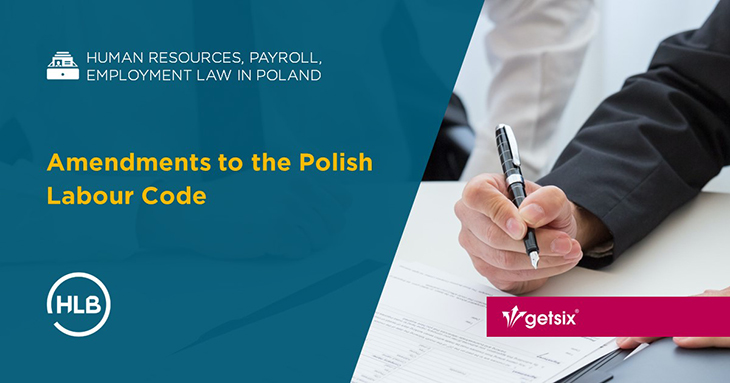Amendments to the Polish Labour Code
As of 26 April, 2023, the provisions of the Act of 9 March 2023 amending the Labour Code Act and certain other acts come into force, implementing two important EU directives:
- on transparent and predictable working conditions in the European Union;
- on work-life balance for parents and caregivers as well as repealing EU Council Directive 2010/18/EU, the so-called work-life balance directive.
Below we outline the most important changes introduced by this Act:
Providing a reason and consulting trade unions on the termination of a fixed-term employment contract
Until now, only the termination of an open-ended employment contract or termination without notice required the employer to state reasons. After the changes, the obligation to give a reason for termination will also exist for fixed-term contracts.
Transitional provisions stipulate that termination of a fixed-term employment contract without justification is possible till the day before the amendments to the Labour Code enter into force, i.e., 25 April 2023.
Extension of information on terms and conditions of employment
Until now, information on the terms and conditions of employment had to be provided within 7 days from conclusion of the employment contract, whereas after the amendments it will be 7 days after the employee has been admitted to work.
The information on the terms and conditions of employment from now on have to include information on:
- the employee’s applicable daily and weekly working time standards,
- the daily and weekly working hours applicable to the employee,
- the breaks to which the employee is entitled to,
- the daily and weekly break to which the employee is entitled,
- the rules on overtime and their compensation,
- in the case of shift work, the rules on the transition from one shift to another,
- in the case of several workplaces, rules on movement between workplaces,
- the components of the employee’s remuneration, and benefits in cash or in kind being other than those agreed in the contract of employment,
- the amount of paid leave to which the employee is entitled, in particular annual leave, or, if it is not possible to determine the amount at the time when the information is given to the employee, the rules for its’ determining and granting,
- the applicable rules on termination of the employment relationship, including the formal requirements, the length of the notice periods, and the time-limit for appeals to an employment tribunal, or, if it is not possible to determine the length of the notice periods at the time when the information is communicated to the employee, the manner of determining those,
- the employee’s right to training, if provided by the employer, in particular the general principles of the employer’s training policy,
- the union rate or other collective agreement to which the worker is subject to and, where a collective agreement is concluded outside the company by joint bodies or institutions, the name of such bodies or institutions,
- where the employer has not established work regulations, the date, place, time, and frequency of payment of remuneration for work, night-time work, and the method of confirming the arrival and presence at work by employees, as well as the method of justifying absence from work adopted by the employer.
In addition, an obligation has been introduced to inform about name of the social security institution no later than 30 days from the date of the employee’s admission to work. This does not apply in the case where the employee chooses his social security institution by himself.
In most cases, the Social Insurance Institution (ZUS) will be indicated here. It is advisable to include this information already in the information on the terms and conditions of employment.
An important improvement is that the information on the terms and conditions of employment and the name of the social security institution can be provided to the employee electronically, provided, however, that it is accessible to the employee with the possibility of printing and storing it. The employer should keep evidence of their transmission or receipt by the employee.
Additional breaks at work
The amendment to Article 134 of the Labour Code introduces additional breaks at work. Thus, if the daily working time of an employee:
- is longer than 9 hours – the employee is entitled to an additional break of at least 15 minutes. Thus, an employee working longer than 9 hours is entitled to a 30-minute break;
- is longer than 16 hours – the employee is entitled to another break of at least 15 minutes.
These breaks are reckoned as working time.
Longer parental leave and higher maternity benefit
Following the changes, the length of parental leave will be 41 or 43 weeks, respectively, in the case of giving birth to one child or in the case of giving multiple birth. At the same time, the legislator introduces an exclusive right to 9 weeks of parental leave for each parent.
In practice, this means that neither parent can waive the right to these 9 weeks in favour of the other – the child’s mother continues to be entitled to 32 weeks of parental leave, while the father acquires 9 weeks of leave.
Employees who were entitled to parental leave from 2 August 2022 until the date of entry into force of this Act can take parental leave in the new size.
Until now, maternity benefit was paid at 100 per cent of the basis for assessment for the first six weeks of parental leave and 60 per cent of the basis for assessment for the remainder of that leave (on average 67.5 per cent of the benefit base). With the amendment to the Labour Code, the amount of benefit for the entire period of parental leave will increase to 70%. If the employee submits a relevant application no later than 21 days after having given birth, the monthly maternity benefit for the period of maternity and parental leave will therefore amount to 81.5 per cent of the basis for assessment of the benefit.
Exemption from work due to force majeure
As from 26.04.2023 onwards, an employee will be entitled to force majeure leave for urgent family matters caused by illness or accident of 2 days or 16 hours upon request made by the employee in the application at the latest on the day the leave is taken. During the period of this leave, the employee retains the right to half salary payment.
Additional carer’s leave days
An additional entitlement is granted to employees who provide personal care or support to a person who is a member of the family or who resides in the same household. This leave is granted at the size of 5 days per calendar year.
It is unpaid leave, but its period counts as part of the period of employment on which the employee’s entitlements depend.
Introduction of so-called flexible working arrangements
The provisions of Directive 2019/1158 define the concept of flexible working arrangements as the possibility for an employee to adapt his or her working arrangements, including through the use of remote working, flexible work schedules, or reduced working hours, to reconcile work and family life.
An employee raising a child, up to the age of 8 years, may submit a request in paper or in electronic form for the application of flexible work arrangements. The application shall be submitted not less than 21 days before the planned start of the use of flexible working arrangements.
Forms of flexible working time organisation include:
- Reduction of working hours
- Remote working
- Intermittent working time system (Article 139 of the Labour Code) – the working time schedule provides for one break in work per day not exceeding 5 hours
- Weekend work system (Article 144 of the Labour Code) – a system of working time where work is performed only on Fridays, Saturdays, Sundays, and public holidays
- Shortened working week system (art. 143 of the Labour Code) – under this system, it is permissible for an employee to perform work for less than 5 days per week with a simultaneous extension of the daily working time not exceeding 12 hours
- Individual schedule of working time (Article 142 of the Labour Code) – at the written request of the employee, the employer may establish an individual schedule of his working time, within the framework of the work system to which the employee is subject to
- Mobile working time (Article 1401 of the Labour Code) – at the written request of the employee, a working time schedule may be applied that provides for different hours of starting work on days which, according to the schedule, are working days for employees, or an interval in which the employee decides on the hour of starting his work on a day which, according to the schedule, is a working day for the employee
The changes introduced aim to increase the protection of workers and shall encourage employers to provide more stable and safer working conditions.
If you have any questions regarding this topic or if you are in need for any additional information – please do not hesitate to contact us:
CUSTOMER RELATIONSHIPS DEPARTMENT

ELŻBIETA NARON
Head of Customer Relationships
Department / Senior Manager
getsix® Group
***





